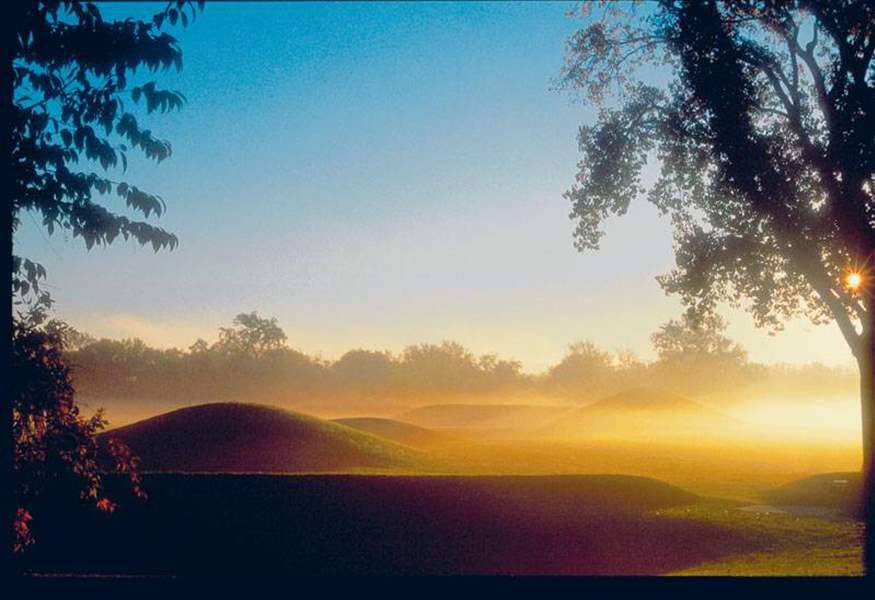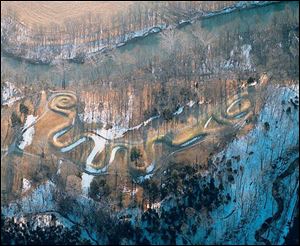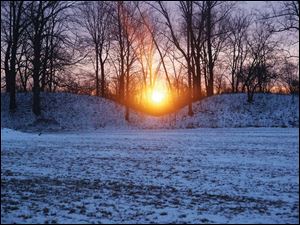
Outdoors: Ohio's ancients built a stellar mound culture
7/27/2008
Mound City is part of the Hopewell Culture National Historic Park at Chillicothe.

Serpent Mound in Adams County, the world s largest effigy mound, is strikingly highlighted by a low winter sun.
Imagine a serpent so big that it snakes along the ground for more than a quarter mile.
Imagine, too, that the head of this great reptilian points right at the sunset on the
horizon at summer solstice in June, on the longest day of the year.
No need to imagine. The serpent is real, if not alive, its body 1,348 feet long, 5 feet high, and 30 feet wide, to be exact. It is frozen in time, an earthen effigy, the great
Serpent Mound. It is tucked away in the woods and hills of Adams County not far from the Ohio River.
The mound is an enduring monument to the most recent of three Native American cultures so well developed and sophisticated that they soon should take their places alongside the Incas, Mayans, and other great past world-class cultures.
That is because Serpent Mound is one of two ancient Ohio nominations for the list of World Heritage Sites. The other is a multi-site collection of equally valuable, historic earthworks, including Fort Ancient in Warren County; Seip Mound and Hopewell Culture National Historic Park with five works, in Ross County, and the famed Newark Earthworks, with its Great Circle and Octagon, in Licking County.

Mound City is part of the Hopewell Culture National Historic Park at Chillicothe.
The term soon, when applied to the World Heritage designations, could be anywhere from next year to within seven or eight years. But it nonetheless will put into the world spotlight these magnificent works some simple, conical burial mounds, others elaborate earthen tombs full of striking handcrafted artifacts of an advanced society, still others cleverly designed and engineered to align with key events of the 18.6-year lunar cycle.
These mounds are not the product of a single monolithic culture that could be characterized as the mound builders, noted Bradley Lepper, an archaeologist with the Ohio Historical Society. Rather, the mounds were the products of a series of cultures, their purposes morphing over time.
The earliest of the mound cultures, the Adena, held sway from roughly 800 B.C. to 100 A.D. The Adenas built mostly conical cemeteries, a few with circular enclosures with the mounds inside.
Next came the Hopewells, from around 100 B.C. to 400 A.D., which continued mound building but with a larger longhouse or loaf-shaped form. Seip Mound is enormous, said Mr. Lepper. Fourteen miles southwest of Chillicothe in Ross County, it stands 30 feet high, 240 feet long, and 130 feet wide.

The winter solstice sunrise is precisely marked by a notch at Fort Ancient.
The Hopewells, moreover, built other giant earthworks, their greatest example perhaps being the Newark Earthworks. Located in Licking County, these works are a layout of circles, squares, and octagons that once covered four and a half square miles.
The Great Circle there alone was 1,200 feet in diameter, swallowing the length of four football fields. The Octagon would hold four Roman colosseums. The two works together incorporate all eight significant lunar alignments. In ways it rivals England s famous Stonehenge.
These works, Mr. Lepper notes, did not function as observatories in our sense. It was a way of bringing the celestial magic they saw in the sky down to earth and incorporating it into their architecture. They were an amazing people.
Indeed, the Hopewell culture had a reach that stretched from the eastern and southern seaboards to the Rockies, as evidenced by the artifacts they left behind:
Copper from the upper Great Lakes, shells from the Gulf of Mexico, mica from the southern Appalachians, obsidian from the Rockies, the latter actually from a site in present-day Yellowstone National Park.
The Serpent Mound and a smaller related one, Alligator Mound in Licking County, were the products of yet another, newer culture, the Fort Ancient Culture, which lasted from about 1000 A.D. to 1650 A.D. SunWatch Village in Dayton is a rebuilt version of a Fort Ancient village, much like Colonial Williamsburg is a reconstruction of an Early American settlement, Mr. Lepper said. It s magnificent.
These great cultures did not so much disappear as they simply changed through time, as Mr. Lepper puts it. It was much as the Model T culture of Tin Lizzies and mud roads in the 1920s gave way to modern automobiles and superhighways. In any case, the earthworks and artifacts the builders left behind are the past s gifts to present-day Ohio, and soon, to the world.
Explore the Earthworks at ohiohistory.org/places, ohiohistorytours.org, or nps.gov/hocu/index.htm, or call the Ohio Historical Society at 1-800-686-6124.